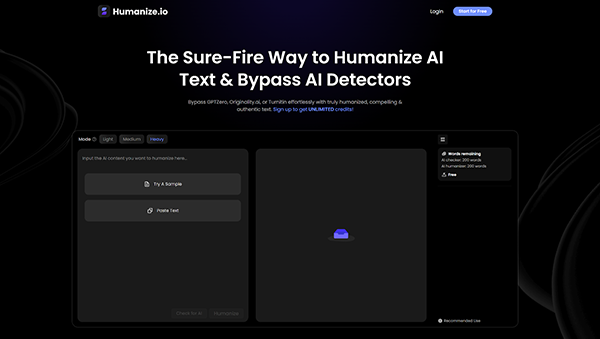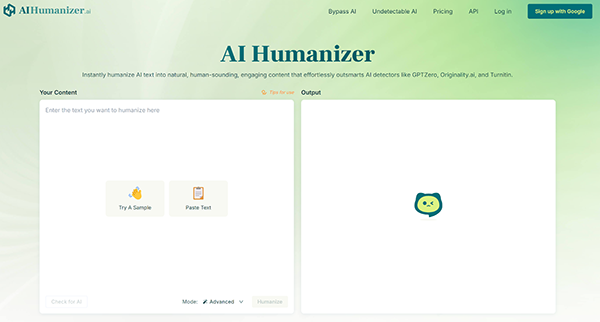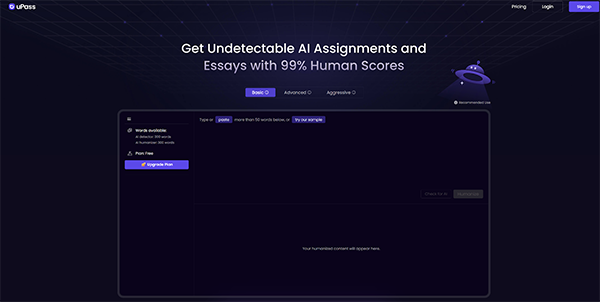As a devoted writer myself, I’ve always been captivated by the power of words. The ability to fabricate tales, evoke emotions, and inspire actions through the written word is a gift I cherish.
However, in recent years, AI has revolutionized the way we create content. In fact, it is too huge that the global AI writing assistant software market was valued at $1.7 billion in 2023.
And while AI-generated content is efficient and informative, it often lacks the warmth and personality of truly engaging writing.
So, by spending countless hours on research, here are my top writing tools that have helped me transform my robotic writing into a human-centric narrative.
Let’s start!

When I first used the AI writing software, I quickly realized the lack of human touch and the ability to engage the audience throughout the article. And, this is right where Humanize.io became my first and probably the most efficient defense against robotic rhetoric.
The tool soon became an absolute game-changer in my AI writing workflow. And the one thing I liked the most about the tool is its refreshingly simple interface.
This allows you to just copy and paste your AI-generated text into the input box and hit the “Humanize” button. And, within seconds, Humanize.io would craft out a human-sounding version of the original text.
So, here take a look at some of the striking features that truly impressed me about Humanize.io:
Overall, Humanize.io proved to be a powerful weapon in my fight against computerized writing. This allowed me to bridge the gap between AI efficiency and human creativity, producing content that resonates with my readers on a deeper level.

Undetectable AI is an advanced AI humanizer tool designed to make AI-generated content sound more natural and human-like. It refines the tone, flow, and style of text to ensure that it reads as if written by a real person.
This is ideal for content creators, marketers, and businesses looking to enhance their communication with a more authentic, engaging voice. It can also easily bypass computerized detection procedures, and it also gives you a tool to detect whether the written content is AI-based or not. Undetectable AI is all in one tool that is a must-have

After conquering the initial robotic hurdle with Humanize.io, I was looking for a bit more control over the humanization process. And, that’s when I discovered AIHumanizer.ai which offers a slightly different approach. It presents the user with several humanization modes — Basic, Standard, and Advanced mode.
The basic mode was just about the general humanization process, the standard version dives a bit deeper into altering sentence structure and adding a creative flow. The Advanced mode is about transforming the content fully into a human tone, which takes the cake, by the way.

Rewritify, as the name suggests, is a paraphrasing tool that comes with a fine capability of rewording, sentences, and paragraphs without altering the core meaning. The best thing about the tool is that it can break down complex concepts into simpler and more understandable language.
So, Rewritify has proved to be a valuable tool in my writing toolkit. Not only did this help me refine my writing but also ensured that my content stood out from the crowd.
Do You Know?
According to Verified Market Research, The AI writing assistant software market was valued at $421.41 Million in 2024 and is expected to reach $2420.32 Million by 2031 — with a growing CAGR of 26.94% from 2024 to 2031.

Another most fine tool that I would like to mention here is the HIX Bypass. This is designed in a way to subtly alter the language of a text, making it less recognizable for AI detection algorithms.
I usually use this tool as a final step in my writing workflow. So, after humanizing the text, I would run it through the HIX Bypass to add an extra layer of protection to my writing.

Though not specifically designed for AI-writing, uPass is a hidden gem that offers a unique approach to text manipulation. This effectively tweaks the sentence that feels a bit too robotic or formal.
Other than that, it also allows you to choose from various options like “Formal to Informal”, “Complex to Simple”, or “Active to Passive.” So, while it may not be as powerful as dedicated humanization tools, it’s still a valuable addition to your writing arsenal.
In closing, AI-powered writing tools are undoubtedly powerful, but they still are not a total replacement for human ingenuity. The tools that I discussed in this read, especially Humanize.io, have not only transformed my writing process but also opened some new possibilities for creativity and productivity.
